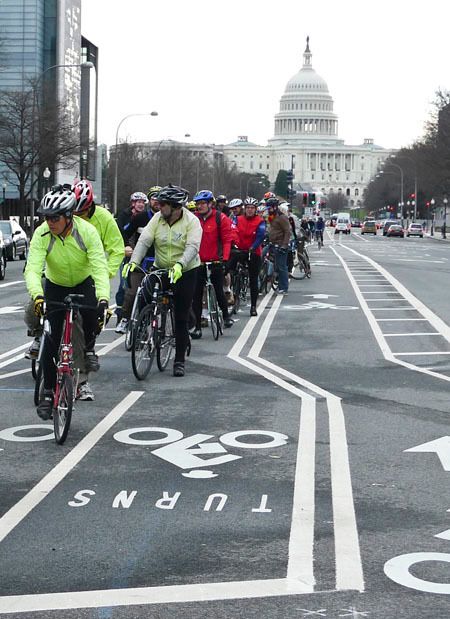
Pennsylvania Avenue bike lane / Over the Bars in Wisconsin
It has been four years since Washington, D.C. released its ambitious sustainability plan, which called for cutting greenhouse gas emissions by 50 percent; increasing the share of trips made via walking, biking or transit to 75 percent; and making 100 percent of the district’s waterways fishable and swimmable — all by 2032. Since then, the district government has accomplished 72 percent of the things it set out to do. And it has made solid progress on the toughest goals. Already, greenhouse gas emissions are down 24 percent, based on 2006 levels, despite four consecutive years of economic and population growth.
At the launch event of Sustainable DC 2.0, district department of the environment and energy director Tommy Wells, outlined the top 10 achievements made by the city since 2013:
#10: Over 100 partners have pledged to help reach the Sustainable DC goals, including all universities in the district and nearly 100 embassies.
#9: The city now have 80 miles of bike lanes and 420 Capitol bike share stations. Some 16.7 percent of the populace now walks or bikes to work. D.C. is tied with Boston for 4th place in this regard, but Wells is confident D.C. will eventually beat Beantown. “I mean, we have much better weather.”
#8: The East Capitol Urban Farm, a three-acre facility that offers access to healthy food and job training. The district has a total of eight urban farms, more than 60 community gardens, and 120-plus school gardens. These efforts and others have helped make 82 percent of the district population food secure.
#7: A new zero waste plan. A comprehensive study now underway will help the city reduces its waste output, which is where the Economist Intelligence Unit said D.C. need to show the greatest progress five years ago. Wells said there are now composting facilities in every ward.
#6: District sustainability awards. Each year, the district government honors those who are leading partners in the effort to achieve the city’s goals. In 2016, American University, Atlas Brew Works, Compost Cab, and others won.
#5: The district now has the most energy star-certified buildings and the most LEED buildings in the nation on a per capita basis. And for the first time, D.C.’s new comprehensive plan includes a sustainability section.
#4: D.C. is ahead of its goals in planting enough trees to reach a 40 percent tree canopy by 2032. The District is now at 38 percent, up 2 percent in the past year when 14,000 trees were planted, which together would cover 800 football fields or two National Malls. Wells gave a shout-out to Casey Trees, ASLA, and American University for helping to accelerate progress.
#3: The Anacostia River is now cleaner than it has been in years, in part due to the 2.7 million square feet of green roofs that help keep stormwater out of the river. Wells was confident the Anacostia can be swimmable and fishable by 2032, “maybe even 2025.”
#2: Sustainable DC ambassadors and volunteers. The district department of energy and the environment has trained over 125 people to go out into their communities and help make the case for sustainability.
#1: D.C. now gets 125,000 megawatts hours from regional wind power sources and 11 megawatts from rooftop solar facilities. 100 percent of D.C. government is now powered by renewable sources. The goal is for 50 percent of the entire district to be powered by wind and solar by 2032; the city’s now at 13.6 percent.
While D.C.’s renewable energy goals take us in the right direction, Hawaii has announced it will aim for 100 percent renewable energy, and Vermont, 75 percent. Portland, Oregon, also recently announced its intention to reach 100 percent renewable. Maybe it’s time for D.C. to up its game a bit?
In a panel after Wells’ announcement, Greater Greater Washington founder David Alpert moderated a panel with former D.C. planning director Harriet Tregoning, Nature Conservancy urban conservation director Khalil Kettering, and Black Women Bike founder Veronica O. Davis, exploring how sustainability relates to resilience, inclusiveness, and health and well-being, and where D.C. needs to go next.
Tregoning said a key issue was D.C. and other big cities are no longer “producing middle class jobs; they are just creating jobs at the high-end — knowledge workers — or at the low-end in restaurants or retail.” She has a plan to resolve this: “If 5 percent of D.C. buildings were retrofitted each year, that would create more middle class jobs and grow the housing and construction economy.” Efforts like these are needed more than ever, particularly given the U.S. shed 89,000 retail jobs since the beginning of the year, and cities like D.C. are “automating the low-end jobs that used to be done by people.”
Davis focused on the need more thoughtful inclusiveness efforts, arguing that educational programs aimed at encouraging African Americans in Ward 7 and 8 to use Capitol bike share have been patronizing. “We’ve been doing bike share for years. It’s called: ‘Let me hold your bike while you go into the store.'” She also said training and education on sustainability isn’t needed in many instances, because African American residents in D.C. are really already living in a sustainable manner, walking or biking to work, or using the Metro.
And Kettering zoomed out to look at the systems-scale, arguing that when looking at sustainability, cities need to look at human health and well-being, housing, and transportation together. The relationship between all of the elements that go into sustainability are “constantly evolving. There are layers of issues and benefits” changing in tandem.
D.C. still has many challenges to overcome in its effort to become truly sustainable. According to a recent report, it’s the 17th most segregated city in the country. In 2013, some 18.9 percent of the population lived below the poverty line, putting D.C. among the top six states and territories of the country with the highest concentrations of poverty. And the poverty rate east of the Anacostia got even worse after the recession.
For Tregoning, the problem is that the federal government, even prior to the Trump administration, has told basically told cities “you are on your own,” so there is even “less federal support.” Given the market “doesn’t create fairness and equity,” cities have to be deliberate in creating policies that can. Mayor Muriel Bowser has increased investments in affordable housing, but some argue the city’s efforts don’t go far enough.
Ending poverty on the east side of the Anacostia will take a sustainability plan that delivers on new green jobs. Sustainability and equality must be considered two sides of the same coin.
